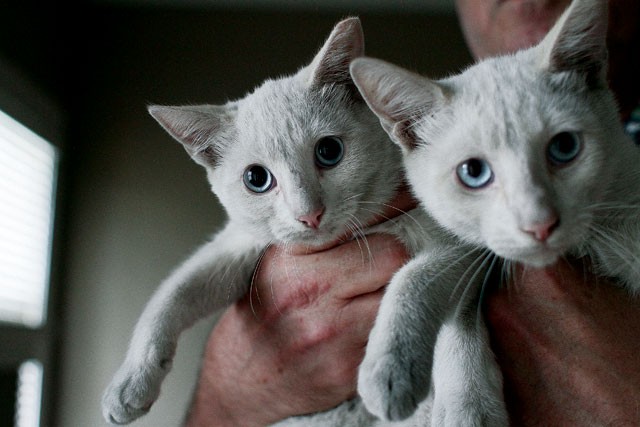Don't feed the stray cats!" they told me. Who? Everyone, it seemed — neighbors, acquaintances, the mail man. They're feral, an infestation. If you feed them, you're just adding to the problem. But when the small tabby crossed into my yard again to nurse her new kittens, I discovered that what had been a litter of four was now reduced to three: one gray, one white, one brown. I couldn't remember the color of the missing kit, but saw these three clearly, and how tired their small mother seemed. Cursing "idiot," off I went to buy cat food at H-E-B.
When cautioned against continuing to feed the now backyard cats because their alley sauntering excited the chained dogs of the block, I persisted. Gray grew up to be a good birder, like his mother. White, crossed-eyed and dark-voiced as a Siamese, was the most friendly. Little Brown, the sole female, was timid and bullied by her mother, but her brothers doted on her. A thin adult male — a striking match to White, started hanging around the yard and kept an eye on the kittens when their mother was away on forays. Never trustful, she remained aloof, but the kittens approached visitors, looking for treats. They developed a taste for baked chicken, preferring spicy BBQ sauce, but disdained my neighbors' offerings of boiled chicken bones. I made plans, endorsed by my landlords (cat rescuers themselves), to get my colony neutered and vetted, but never got around to it. Last spring, during a late night working jag that lasted a few weeks, I vaguely noticed that the two white cats had not been seen for several days. Off on night journeys, I supposed. But when I finally got home at a decent hour, my neighbors, who shared the yard with me, told me the bad news. First one, then the other white cat had been found in the front yard, bloodied, with a broken neck. The work, it seemed, of a neighbor dog that often escaped his yard to go cat hunting.
When the rains stopped, both Little Brown and her mother were pregnant. Eventually, they both gave birth. For more than two weeks, the mother cat seldom came by, while Little Brown continued to sun herself in the yard. It seemed the older female was off to a hidden lair, but the young one had lost her kittens. But one day she disappeared, then returned with two white kittens in tow. The larger of the two still had one eye closed. I picked each up in turn, while Little Brown looked on patiently. "OK," I told her, "you're finally going to the vet."
When speaking with potential landlords, asking "May I bring three feral cats with me?" most often causes a stunned silence, followed by, "I don't think that's a very good idea." After searching a month for a place to relocate with the cats I finally met with a landowner who followed the usual silence with, "Yes, I took in some strays, too."
A phone number next to my zip code on the San Antonio Feral Cat Coalition website led me to Kay Keane, a member of the Animal Welfare Society of Bandera. Her group, which also operates in Boerne and Bexar County, now has four Trap-Neuter-Release trappers. They began in 1998 long before TNR was legal in Texas. "There have been little old ladies doing TNR for decades around here, regardless," she told me recently. She explained that a grant (see "No kill ever?" page 18) through San Antonio Animal Care Services had chosen 14 zip codes in SA to receive funds for feral cat neutering, chosen as target areas because they reported high numbers of cats at ACS intake. Instead of euthanizing stray cats, TNR programs neuter and vaccinate the cat, then return it to its origin to continue holding turf — but without adding to the animal population explosion. I had decided to move to a new neighborhood, but my almost-wild but not-quite domestic cats were still eligible for the project, called the Community Cat Program. Keane would come by with several traps, pick up the cats, then take them to SpaySA, where they would receive a course of treatments, including spay/neuter surgery, vaccines against rabies and distemper, ivermectin for worms, and antibiotic shots. To mark them as TNR cats (and theoretically save them from euthanasia if they happened to fall in to the clutches of ACS animal control officers) their left ear would be cut, or "tipped," a process I balked at, but which hasn't seemed to bother them. Since they were being moved to a new location, Keane suggested I contact Jenny Burgess of Texas Barn Cats.
When outdoor cats aren't ready to domesticate, but have no colony to return to, Texas Barn Cats places them in barns as working cats, where they earn their keep by keeping the vermin population in check. Part of the process involves keeping the cat in a kennel (a large cage) for two weeks so they can start establishing their territory while other animals have a chance to look at the them, smell, and generally get used to the new resident. Though she doesn't usually provide people not using her service with kennels, Burgess offered to loan me one. Burgess is also active with the San Antonio Feral Cat Coalition, and teaches TNR classes to new volunteers weekly at the Thousand Oaks Library. Born in England, Burgess finds attitudes towards cats in Texas not always as pleasant as the English habit, which accepts cats as part of the indoor household while allowing them to go in and out of doors as they wish. Asking me about my relationship with the cats, I confessed that though the kittens liked to be handled, their mother preferred to keep a few feet off. Reminding me of the dangers of dogs, which I knew all too well, Burgess asked me to consider giving indoor life a try for the cats until I could arrange safe outdoor perches, or even better, a fence or other enclosure.
Two days after the three cats — and one bonus, the old mother cat — had been picked up and had their surgeries, my three were brought over to my new apartment, while the older cat was returned to her own seldom seen kittens, who had avoided detection. Gray had been missing for some days, so he escaped a good vetting, too. Though part of the original colony, the older cat and Gray left the backyard when Little Brown brought up her litter, though they had sometimes visited. Is someone feeding them? Are they OK? I don't know.
Following protocol, I kept my three cats in their kennel for the first few days, though continuing to pick up and play with the two kittens several times a day. They have ridiculous names: the male is Jumper, the female, Itsy. Little Brown cowered in the kennel, but on the third day, left to explore the one room I allowed them. Most time was spent back in the kennel, but all three made their opinions known by much comment. Over the days, all three were given the entire apartment to wander about. The kittens resumed their daily games of Greco-Roman wrestling, adding new skills of wood floor sliding to their athletic routines. At first inquisitive, after two weeks Little Brown found the most hard to find hiding places in the apartment, where she would spend most of her time in silence. I started to think that perhaps she would not make the transition, and that the whole group should get on with acclimating themselves as TNR cats in a new location, where they would be fed as before, but live outside all the time.
Then the thunder and lightening struck last weekend. I stayed up with the kittens, who decided to play with balls when they weren't hiding in corners. Sometime during the night, I kicked a ball into the dining room, and Little Brown batted it back at me. It was the first time I had ever seen her play (her own dam was a severe mother). The next two days, instead of hiding when I came in, she instead left her place, and as she had when we all lived in that other place, looked straight at me and talked and talked.
Now, I find the kittens sleeping on the corner of my bed, and while their mother hasn't made that jump yet, she is tucked nearby in her own cat dreams. Adopting even quasi-feral cats isn't for the faint of heart. Outdoor cats are finicky clean, and mine won't tolerate litter box smells. So prepare a large space, and use the mop often. They need privacy, but much interaction, too. And remember, it's up to them to decide whether or not to adopt you into their colony.
For more information contact The San Antonio Feral Cat Coalition at sanatonioferalcats.org.



















